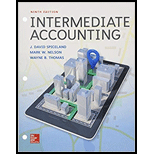
Concept explainers
Current– noncurrent classification of debt
• LO13–1, LO13–4
At December 31, 2018, Newman Engineering’s liabilities include the following:
1. $10 million of 9% bonds were issued for $10 million on May 31, 1999. The bonds mature on May 31, 2029, but bondholders have the option of calling (demanding payment on) the bonds on May 31, 2019. However, the option to call is not expected to be exercised, given prevailing market conditions.
2. $14 million of 8% notes are due on May 31, 2022. A debt covenant requires Newman to maintain current assets at least equal to 175% of its current liabilities. On December 31, 2018, Newman is in violation of this covenant. Newman obtained a waiver from National City Bank until June 2019, having convinced the bank that the company’s normal 2 to 1 ratio of current assets to current liabilities will be reestablished during the first half of 2019.
3. $7 million of 11% bonds were issued for $7 million on August 1, 1989. The bonds mature on July 31, 2019. Sufficient cash is expected to be available to retire the bonds at maturity.
Required:
What portion of the debt can be excluded from classification as a current liability (that is, reported as a noncurrent liability)? Explain.
Want to see the full answer?
Check out a sample textbook solution
Chapter 13 Solutions
INTERMEDIATE ACCOUNTING(LL)-W/CONNECT
- Provide correct answer this general accounting questionarrow_forwardKenzo Distribution updates its inventory perpetually. Its beginning inventory is $62,000, goods purchased during the period cost $178,000, and the cost of goods sold for the period is $195,000. What is the amount of the ending inventory?arrow_forwardI am trying to find the accurate solution to this general accounting problem with the correct explanation.arrow_forward
- Please show me the correct approach to solving this financial accounting question with proper techniques.arrow_forwardCan you solve this general accounting problem with appropriate steps and explanations?arrow_forwardBansai, age 66, retires and receives a $1,450 per month annuity from his employer's qualified pension plan. Bansai made $87,600 of after-tax contributions to the plan before retirement. Under the simplified method, Bansai's number of anticipated payments is 240. What is the amount includible in income in the first year of withdrawals assuming 12 monthly payments? A. $10,560 B. $13,020 C. $17,400 D. $8,220arrow_forward
- Please provide the correct answer to this financial accounting problem using accurate calculations.arrow_forwardCan you demonstrate the accurate method for solving this financial accounting question?arrow_forwardPlease help me solve this financial accounting question using the right financial principles.arrow_forward
- I need help with this general accounting question using standard accounting techniques.arrow_forwardPlease provide the answer to this general accounting question with proper steps.arrow_forwardMidori Hardware uses the perpetual inventory system. At the beginning of the quarter, Midori Hardware has $56,000 in inventory. During the quarter, the company purchased $12,500 of new inventory from a vendor, returned $2,200 of inventory to the vendor, and took advantage of discounts from the vendor of $600. At the end of the quarter, the balance in inventory is $48,300. What is the cost of goods sold? i. $16,900 ii. $17,400 iii. $18,200 iv. $19,500 v. $15,800arrow_forward
 Cornerstones of Financial AccountingAccountingISBN:9781337690881Author:Jay Rich, Jeff JonesPublisher:Cengage Learning
Cornerstones of Financial AccountingAccountingISBN:9781337690881Author:Jay Rich, Jeff JonesPublisher:Cengage Learning Intermediate Accounting: Reporting And AnalysisAccountingISBN:9781337788281Author:James M. Wahlen, Jefferson P. Jones, Donald PagachPublisher:Cengage Learning
Intermediate Accounting: Reporting And AnalysisAccountingISBN:9781337788281Author:James M. Wahlen, Jefferson P. Jones, Donald PagachPublisher:Cengage Learning Financial Accounting: The Impact on Decision Make...AccountingISBN:9781305654174Author:Gary A. Porter, Curtis L. NortonPublisher:Cengage Learning
Financial Accounting: The Impact on Decision Make...AccountingISBN:9781305654174Author:Gary A. Porter, Curtis L. NortonPublisher:Cengage Learning


